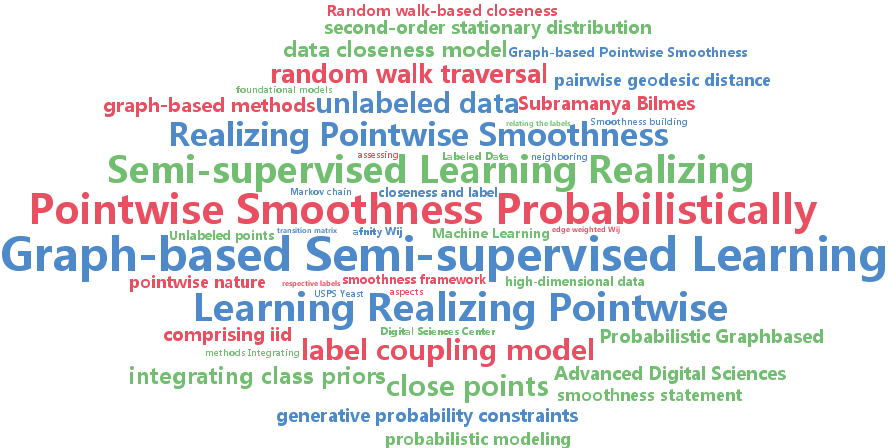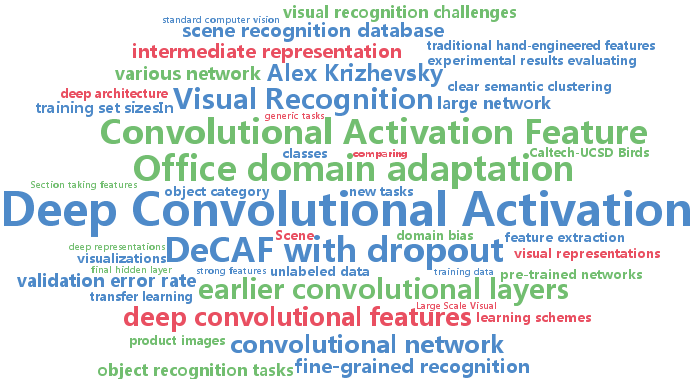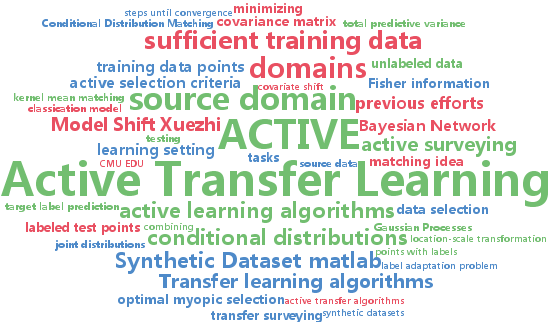unlabeled data
-
Yuan Fang and Kevin Chang and Hady Lauw
Graph-based Semi-supervised Learning: Realizing Pointwise Smoothness Probabilistically (pdf)
As the central notion in semi-supervised learning, smoothness is often realized on a graph representation of the data. In this paper, we study two complementary dimensions of smoothness: its pointwise nature and probabilistic modeling. While no existing graph-based work exploits them in conjunction, we encompass both in a novel framework of Probabilistic Graph-based Pointwise Smoothness (PGP), building upon two foundational models of data closeness and label coupling. This new form of smoothness axiomatizes a set of probability constraints, which ultimately enables class prediction. Theoretically, we provide an error and robustness analysis of PGP. Empirically, we conduct extensive experiments to show the advantages of PGP.
-
Jeff Donahue and Yangqing Jia and Oriol Vinyals and Judy Hoffman and Ning Zhang and Eric Tzeng and Trevor Darrell
DeCAF: A Deep Convolutional Activation Feature for Generic Visual Recognition (pdf)
We evaluate whether features extracted from the activation of a deep convolutional network trained in a fully supervised fashion on a large, fixed set of object recognition tasks can be re-purposed to novel generic tasks. Our generic tasks may differ significantly from the originally trained tasks and there may be insufficient labeled or unlabeled data to conventionally train or adapt a deep architecture to the new tasks. We investigate and visualize the semantic clustering of deep convolutional features with respect to a variety of such tasks, including scene recognition, domain adaptation, and fine-grained recognition challenges. We compare the efficacy of relying on various network levels to define a fixed feature, and report novel results that significantly outperform the state-of-the-art on several important vision challenges. We are releasing DeCAF, an open-source implementation of these deep convolutional activation features, along with all associated network parameters to enable vision researchers to be able to conduct experimentation with deep representations across a range of visual concept learning paradigms.
-
Xuezhi Wang and Tzu-Kuo Huang and Jeff Schneider
Active Transfer Learning under Model Shift (pdf)
Transfer learning algorithms are used when one has sufficient training data for one supervised learning task (the source task) but only very limited training data for a second task (the target task) that is similar but not identical to the first. These algorithms use varying assumptions about the similarity between the tasks to carry information from the source to the target task. Common assumptions are that only certain specific marginal or conditional distributions have changed while all else remains the same. Alternatively, if one has only the target task, but also has the ability to choose a limited amount of additional training data to collect, then active learning algorithms are used to make choices which will most improve performance on the target task. These algorithms may be combined into active transfer learning, but previous efforts have had to apply the two methods in sequence or use restrictive transfer assumptions. We propose two transfer learning algorithms that allow changes in all marginal and conditional distributions but assume the changes are smooth in order to achieve transfer between the tasks. We then propose an active learning algorithm for the second method that yields a combined active transfer learning algorithm. We demonstrate the algorithms on synthetic functions and a real-world task on estimating the yield of vineyards from images of the grapes.
-
Yujia Li and Rich Zemel
High Order Regularization for Semi-Supervised Learning of Structured Output Problems (pdf)
Semi-supervised learning, which uses unlabeled data to help learn a discriminative model, is especially important for structured output problems, as considerably more effort is needed to label its multidimensional outputs versus standard single output problems. We propose a new max-margin framework for semi-supervised structured output learning, that allows the use of powerful discrete optimization algorithms and high order regularizers defined directly on model predictions for the unlabeled examples. We show that our framework is closely related to Posterior Regularization, and the two frameworks optimize special cases of the same objective. The new framework is instantiated on two image segmentation tasks, using both a graph regularizer and a cardinality regularizer. Experiments also demonstrate that this framework can utilize unlabeled data from a different source than the labeled data to significantly improve performance while saving labeling effort.



